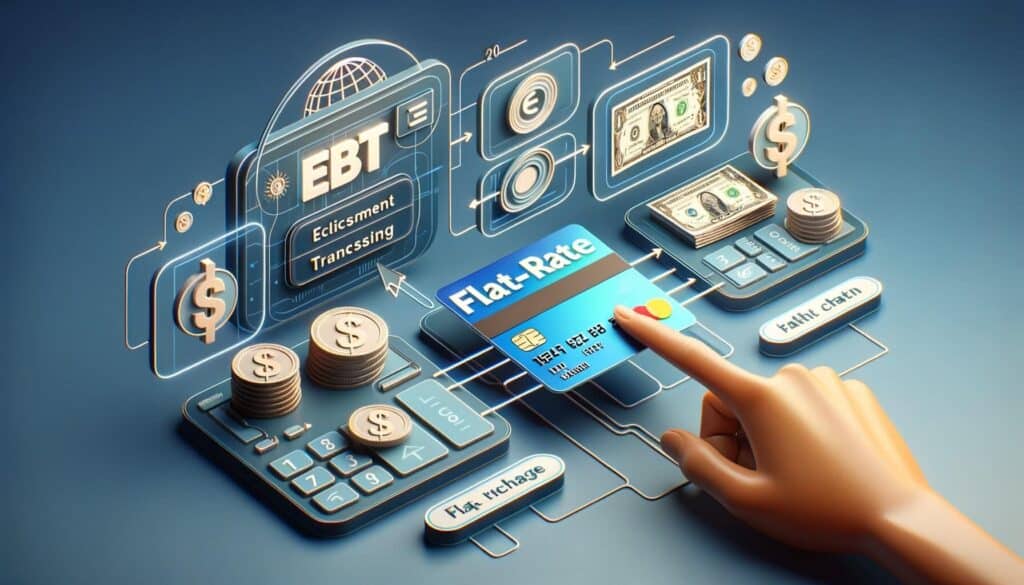
By admin April 16, 2025
In today’s digital age, electronic benefit transfer (EBT) processing has become an essential part of the payment landscape. EBT processing allows individuals to access government assistance programs, such as the Supplemental Nutrition Assistance Program (SNAP), through a card-based system. One of the emerging trends in EBT processing is the adoption of flat-rate pricing models.
In this article, we will explore what flat-rate EBT processing is, how it works, and the benefits it offers to merchants. We will also address common misconceptions and discuss the future of this payment processing method.
Understanding the Basics of EBT Processing
Before delving into flat-rate EBT processing, it is important to understand the fundamentals of EBT processing itself. EBT processing is a method of electronically transferring funds from government assistance programs to eligible individuals. Instead of receiving paper checks or vouchers, recipients are issued EBT cards, similar to debit cards, which can be used to purchase eligible items at authorized retailers.
Traditionally, EBT processing fees were based on a percentage of the transaction amount, which could vary depending on the provider and the type of transaction. This pricing model often resulted in unpredictable costs for merchants, making it difficult to budget and plan for expenses. Flat rate EBT processing aims to address this issue by offering a fixed fee for each transaction, regardless of the transaction amount.
Benefits of Flat-Rate EBT Processing for Merchants

Flat-rate EBT processing offers several advantages for merchants. Firstly, it provides predictability and simplicity in terms of pricing. With a fixed fee per transaction, merchants can easily calculate their EBT processing costs and incorporate them into their overall budget. This eliminates the uncertainty associated with percentage-based pricing models, where fees can fluctuate based on transaction amounts.
Secondly, flat-rate EBT processing can lead to cost savings for merchants. In traditional EBT processing, higher transaction amounts would result in higher fees. However, with flat-rate pricing, merchants pay the same fee regardless of the transaction amount. This can be particularly beneficial for businesses that frequently process large EBT transactions, as they can save significantly on processing fees.
Furthermore, flat rate EBT processing can streamline accounting processes for merchants. With a fixed fee per transaction, it becomes easier to reconcile EBT transactions and track expenses. This simplification can save time and resources for businesses, allowing them to focus on other aspects of their operations.
How Flat-Rate EBT Processing Works

Flat-rate EBT processing works by charging a fixed fee for each EBT transaction, regardless of the transaction amount. This fee is typically determined by the EBT processing provider and may vary depending on factors such as the provider’s pricing structure and the specific services offered.
When a customer makes a purchase using their EBT card, the transaction is processed through the EBT processing provider’s system. The provider verifies the customer’s eligibility and deducts the transaction amount from their EBT account. Simultaneously, the provider charges the merchant the fixed fee for processing the transaction.
Choosing the Right Flat-Rate EBT Processing Provider

Selecting the right flat-rate EBT processing provider is crucial for merchants looking to optimize their payment processing operations. When evaluating potential providers, merchants should consider several factors.
Firstly, merchants should assess the provider’s reputation and experience in the EBT processing industry. It is important to choose a provider with a proven track record of reliability and security. Additionally, merchants should consider the provider’s customer support capabilities, as prompt and efficient support can be critical in resolving any issues that may arise.
Secondly, merchants should evaluate the provider’s pricing structure and fee transparency. While flat-rate pricing offers predictability, it is essential to understand the specific fees associated with each transaction. Merchants should inquire about any additional fees, such as setup fees or monthly fees, to ensure they have a comprehensive understanding of the costs involved.
Common Misconceptions about Flat-Rate EBT Processing

Despite the benefits and growing popularity of flat-rate EBT processing, there are some common misconceptions surrounding this payment processing method. One misconception is that flat-rate pricing is always more expensive than percentage-based pricing. While it is true that flat-rate pricing may not always be the most cost-effective option for every merchant, it can offer significant savings for businesses that process large EBT transactions.
Another misconception is that flat-rate EBT processing lacks flexibility. Some merchants believe that a fixed fee per transaction may not accommodate their specific business needs. However, many flat-rate EBT processing providers offer customizable solutions that can be tailored to meet the unique requirements of different businesses.
Step-by-Step Guide to Setting Up Flat-Rate EBT Processing
Setting up flat-rate EBT processing involves several steps to ensure a smooth transition and successful implementation. Follow this step-by-step guide to get started:
1. Research and select a reputable flat-rate EBT processing provider that meets your business’s needs.
2. Contact the provider and inquire about their onboarding process. They will guide you through the necessary documentation and requirements.
3. Gather the required documents, which may include business registration information, tax identification numbers, and banking details.
4. Complete the provider’s application form, providing accurate and up-to-date information about your business.
5. Submit the application along with the required documents to the provider for review.
6. Await approval from the provider. This process may take a few days to a couple of weeks, depending on the provider’s internal procedures.
7. Once approved, the provider will provide you with the necessary equipment, such as payment terminals or POS system integration instructions.
8. Set up the equipment according to the provider’s instructions, ensuring proper connectivity and functionality.
9. Test the EBT processing system to ensure it is working correctly. Process a few test transactions to verify that funds are being deposited into your account.
10. Train your staff on how to process EBT transactions and address any questions or concerns they may have.
Tips for a Smooth Transition to Flat-Rate EBT Processing
Transitioning to flat-rate EBT processing can be a seamless process with proper planning and preparation. Here are some tips to ensure a smooth transition:
1. Research and compare providers: Take the time to research and compare different flat-rate EBT processing providers. Look for providers that offer the features and support that align with your business needs.
2. Evaluate your current EBT processing system: Assess your current EBT processing system and identify any areas for improvement. Consider factors such as transaction fees, customer support, and overall efficiency.
3. Train your staff: Provide comprehensive training to your staff on how to use the new flat-rate EBT processing system. This will ensure that they are familiar with the features and can assist customers effectively.
4. Communicate with your customers: Inform your customers about the transition to flat-rate EBT processing and any changes they may experience. This will help manage expectations and minimize any potential disruptions.
5. Monitor and evaluate the transition: Continuously monitor the transition process and gather feedback from both your staff and customers. This will allow you to address any issues or concerns promptly and make necessary adjustments.
Common Challenges and Solutions in Flat-Rate EBT Processing
While flat-rate EBT processing offers numerous benefits, merchants may encounter some challenges during implementation and operation. One common challenge is ensuring compliance with EBT program regulations. Merchants must adhere to strict guidelines to maintain eligibility for accepting EBT payments. Failure to comply can result in penalties or even loss of EBT acceptance privileges. To overcome this challenge, merchants should stay informed about program updates and regulations, and regularly review their processes to ensure compliance.
Another challenge is managing high transaction volumes during peak periods, such as holidays or weekends. Flat-rate EBT processing providers typically offer scalable solutions to handle increased transaction volumes efficiently. Merchants should communicate their expected peak periods to the provider and ensure that their systems can handle the anticipated load.
Exploring the Future of Flat-Rate EBT Processing
The future of flat-rate EBT processing looks promising, as more merchants recognize the benefits it offers. With its simplicity, predictability, and potential cost savings, flat-rate pricing is likely to continue gaining traction in the EBT processing industry.
Furthermore, advancements in technology and the increasing adoption of digital payment methods are expected to shape the future of flat-rate EBT processing. As more individuals transition to using mobile wallets and digital payment platforms, EBT processing providers may need to adapt their systems to accommodate these emerging trends.
Frequently Asked Questions about Flat-Rate EBT Processing
Q: Can I use flat-rate EBT processing for all types of EBT transactions?
A: Yes, flat-rate EBT processing can be used for all eligible EBT transactions, including SNAP and other government assistance programs.
Q: How do I know if a flat-rate EBT processing provider is authorized by the government?
A: You can verify the authorization of a flat-rate EBT processing provider by checking with the government agency responsible for EBT programs in your state.
Q: Can I still accept other forms of payment, such as credit or debit cards, with flat-rate EBT processing?
A: Yes, many flat-rate EBT processing providers offer additional payment options, such as credit and debit card processing, under the same rate.
Q: Is flat-rate EBT processing suitable for small businesses?
A: Yes, flat-rate EBT processing is suitable for businesses of all sizes. It provides a predictable and consistent cost structure, making it easier for small businesses to manage their finances.
Q: Can I switch to a different flat-rate EBT processing provider if I am not satisfied with my current one?
A: Yes, you can switch to a different flat-rate EBT processing provider if you are not satisfied with your current one. However, it is important to review the terms of your contract and any potential fees or penalties for early termination.
Conclusion
Flat-rate EBT processing offers a simplified and cost-effective solution for merchants processing EBT transactions. With its predictable pricing, potential cost savings, and streamlined accounting processes, flat-rate pricing is gaining popularity in the EBT processing industry.
By choosing the right flat-rate EBT processing provider and dispelling common misconceptions, merchants can optimize their payment processing operations and adapt to the evolving landscape of digital payments. As technology continues to advance, the future of flat-rate EBT processing looks promising, with potential enhancements to accommodate emerging trends in digital payments.